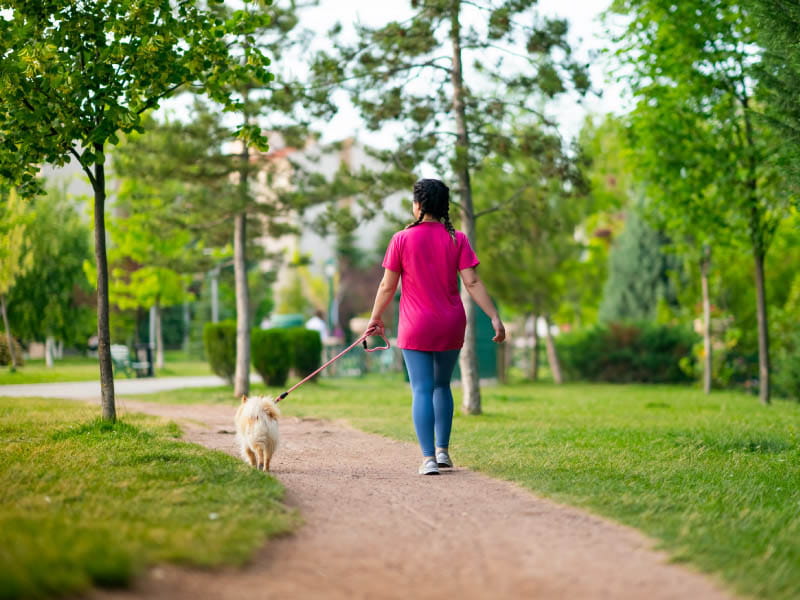For green spaces to be most beneficial to health, they need to be walkable
By Thor Christensen, American Heart Association News

The positive health impact of green space isn't just about where you live, but how easily you can access nature, according to new research.
Previous studies have suggested that simply living in neighborhoods filled with trees, grass and plants can reduce heart disease risk. For the new study, researchers explored the relationship between green space and cardiovascular risk factors and diseases by using two metrics: NatureScore, a composite measure of the amount and quality of nature, and walk score, which gauges how easy or hard it is to walk around a neighborhood.
Researchers looked at a medical database of more than 1 million adults in the Houston metro area who were 52 years old on average. Based on where they lived, each person was categorized by a NatureScore of nature-deficient, nature-adequate, nature-rich or nature-utopia, as well as a walk score of car-dependent for all errands, car-dependent for most errands, somewhat walkable or very walkable/walker's paradise.
When researchers looked simply at green space, they found cardiovascular diseases and risk factors were actually more common in people living in neighborhoods with a high NatureScore, compared with those living in less green neighborhoods – a surprising finding, said lead researcher Dr. Omar Mohamed Makram, an internal medicine resident at the Medical College of Georgia at Augusta University and a former postdoctoral fellow at the Center for Health and Nature at Houston Methodist Hospital.
But when walkability scores were factored in, people living in the highest NatureScore areas had 9% lower odds of cardiovascular disease risk factors such as high blood pressure, high cholesterol, obesity and diabetes than those living in the lowest NatureScore areas. They also had 4% lower odds of cardiovascular diseases, which included coronary heart disease, peripheral artery disease and stroke.
Researchers then zeroed in on walk scores and found that those living in both high nature and highly walkable areas had lower odds of risk factors that those living in high nature but less walkable areas.
"The results highlight the importance of both exposure and access to nature: To maximize the benefits of green space, people have to interact with nature," Makram said.
The findings, presented this month at the American Heart Association's Scientific Sessions conference in Philadelphia, are considered preliminary until full results are published in a peer-reviewed journal.
"Our findings suggest policymakers should support initiatives that bring more accessible green spaces to areas where they are lacking, especially in underserved communities," said Makram, who added that creating more green spaces near mixed-use developments and transit hubs could improve a neighborhood's walkability as well as its access to nature.
"The results show that it's important for physicians to be aware of social determinants of health, including where patients live, in order to give personalized advice about walking or other physical activities," he said.
The research was limited because it didn't prove cause and effect or delve into which activities in nature are most beneficial, Makram said. He called for future research to pinpoint the best possible length to spend in nature for maximum health benefits. "Is it a five-minute walk? A 15-minute walk? Or a whole day or week immersed in nature?" he asked.
Dr. Ray Yeager, an assistant professor of medicine at the University of Louisville in Kentucky, said the study adds important information to a topic in dire need of more data.
"There's a general notion that green space is good for health, but there's really not a lot of evidence to understand the many complexities involved between vastly different forms of green spaces, communities and built environments," he said.
Yeager, who has studied the topic but was not involved in the new research, said urban green space could flourish in the future as policymakers try to battle climate change. He noted that in September, the U.S. Department of Agriculture's Forest Service awarded more than $1 billion in grants to plant and maintain trees in cities and suburbs in all 50 states. "For the affected communities, that could really be a major advance for cardiovascular health and public health in general," he said.
But, Yeager added, many questions remain about the relationship between green space and health.
"The beneficial effects of nature aren't homogenous across communities," he said. "There's still a need for more research to find out how specific communities and which socioeconomic groups can benefit the most."
Find more news from Scientific Sessions.





